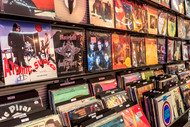EP vs LP Albums: What's the Difference?
Posted by House of Marley on Apr 1st 2024
In the ever-evolving landscape of music, the terms EP and LP are frequently tossed around, but what exactly do they mean? These abbreviations, standing for 'Extended Play' and 'Long Play' respectively, are more than just industry jargon. They represent different album formats that have shaped the music industry and how artists present their work. Let's dive into the world of EPs and LPs, exploring their differences, significance, and why they matter in the age of streaming platforms and digital music.
What is an EP?
An EP, or Extended Play, is a musical recording that contains more tracks than a single song but is too short to qualify as a full-length album. Typically, an EP will have three to five tracks and is considered a significant album format for artists, especially emerging ones. It allows musicians to showcase a broader range of their work without the commitment of producing a full album.
EPs are often seen as a canvas for experimentation, where artists can explore new sounds and styles without the pressure of filling an entire album. They're also a great way for artists to maintain visibility and keep fans engaged between larger projects. EPs were and still are a popular format for their affordability and convenience, and they continue to be a vital part of the music industry.
Classifying a Release as an EP
The specific criteria for classifying a release as an EP can vary. For example, in the United Kingdom, an EP can appear on either the album or the single chart, and the Official Chart Company classifies any record with more than four tracks or with a playing time of more than 25 minutes as an album for sales-chart purposes.[1]
Similarly, on Apple Music and iTunes, a release with four to six tracks and a duration of under 30 minutes is categorized as an EP, while a release with seven or more tracks or a duration of over 30 minutes is categorized as an album.[2]
Is an EP Considered An Album?
While an EP shares some similarities with albums, they are not quite the same. An EP is often used by artists to release new music between albums or to introduce new material to fans. It's a format that's particularly popular among indie artists and those in the early stages of their music career.
EPs can be a strategic choice for artists testing new styles or themes before committing to a full-length project. By releasing music, they offer a glimpse into an artist's evolving sound and can sometimes become stepping stones to more ambitious works. For fans, EPs provide a quick and accessible way to experience new music from their favorite artists.
What is an LP?
An LP record, or Long Play, refers to a vinyl record format that typically contains a full album. In the digital music era, LP has come to be synonymous with a full length album, regardless of the medium. An LP usually contains at least seven or eight tracks, offering a more comprehensive representation of an artist's work.
It's the standard format for album length and is what most people think of when they refer to an album. LPs are cherished for their ability to tell a complete story, whether it's through a concept album or a collection of songs that represent a particular period in an artist's career. The LP format has been instrumental in shaping the music industry, providing a platform for artists to express their vision in depth.
EP vs LP: Main Differences
In the diverse world of music formats, understanding the differences between an EP and an LP is key for both artists and listeners. These two types of records, each with their unique characteristics and purposes, have shaped the way music is created and consumed. While they may seem similar at first glance, there are several distinct differences between EPs and LPs that affect everything from the length and content of the music release to the way they are enjoyed by audiences. Let's delve into these differences to gain a clearer understanding of what sets these two formats apart.
Size
Again, the immediately obvious difference between EPs and LPs is their size. An EP is shorter in length, both in terms of the number of songs and the total runtime. LPs, on the other hand, offer a more extensive listening experience, often unfolding a more complex or complete artistic vision. This difference in size and scope often influences the way artists approach the creation of EPs and LPs, with an EP release serving as a snapshot and LP release providing a full picture. The EP's shorter format is ideal for artists who want to give a taste of their style or introduce new concepts without committing to a full studio album, while LPs are suited for more comprehensive musical explorations.
Use of Adapters
When it comes to vinyl records, EPs and LPs can differ in their physical size. Some EPs are produced on 7-inch vinyl that may require an adapter to be played on a standard record player. LPs are typically 12 inches and fit easily on most turntables without the need for additional equipment. This difference in size can affect the way music is experienced, with smaller EPs often being more portable and convenient for quick listening sessions. The need for an adapter with certain EPs also adds an extra step in the listening process, which can be a consideration for vinyl enthusiasts.
Spin Rate
The spin rate, or revolutions per minute (RPM), also differs between EPs and LPs. Most LPs play at 33 1/3 RPM, while EPs, especially those on 7-inch vinyl, often spin at 45 RPM. This difference in spin rate can affect the sound quality and how the music is experienced. The faster spin of a 45 RPM EP can result in a higher fidelity sound, making it a preferred choice for single releases where sound quality is paramount. Conversely, the 33 1/3 RPM of LPs allows for more music to be stored on each side, making them ideal for full-length albums.
Learn more about 33 vs 45 vs 78 RPM in our blog.
Why Does EP vs LP Matter?
Understanding the distinction between EPs and LPs is crucial for both artists and music fans. For artists, choosing between an EP and an LP can impact their music production, release strategy, and how they connect with their audience. For fans, knowing the difference enhances the listening experience and appreciation of the artist's work.
In an era where music is often consumed in digital formats, the choice between releasing an EP or an LP can also influence how an artist's work is perceived in the broader context of their music career. Additionally, for vinyl collectors, the distinction between EPs and LPs can affect how to start collecting vinyl records and the curation that follows, as each format offers a unique listening experience.

Give Your EPs and LPs the Best with House of Marley Turntables
Whether you're spinning an EP or an LP, the quality of your turntable can significantly impact your listening experience. House of Marley offers a range of turntables that are not only high in sound quality but also align with sustainable and ethical manufacturing practices. Our turntables, like the Stir It Up Turntable, are designed to bring out the best in both EPs and LPs, ensuring that every track, whether it's from a compact EP or a full-length LP, is heard in all its glory.
With House of Marley, you're not just playing music; you're experiencing it on players and speakers in the most authentic way possible. The company's commitment to eco-friendly materials and high-quality audio makes their turntables an ideal choice for environmentally conscious music lovers. House of Marley's products not only elevate the sound of your vinyl records but also contribute to a more sustainable world, making them a top choice for modern audiophiles.
The world of EPs and LPs is indeed rich and varied, offering different avenues for artists to express themselves and for fans to enjoy music. Understanding these formats is key to appreciating the artistry behind music production and the joy of listening to records. Whether you're an indie artist releasing your first EP or a seasoned music lover adding to your vinyl collection, the choice between an EP and an LP is a significant one.
So next time you're about to spin a record or stream a new album, consider the format and the journey it represents in the artist's musical journey.
Sources:
- Wikipedia Editors. 2019. “Extended Play.” Wikipedia. November 23, 2019. https://en.wikipedia.org/wiki/Extended_play.
- S, Priscilla. 2022. “What Is the Difference between Single, EP and Albums?” CD Baby Help Center. December 13, 2022. https://support.cdbaby.com/hc/en-us/articles/360008275672-What-is-the-difference-between-Single-EP-and-Albums-.













